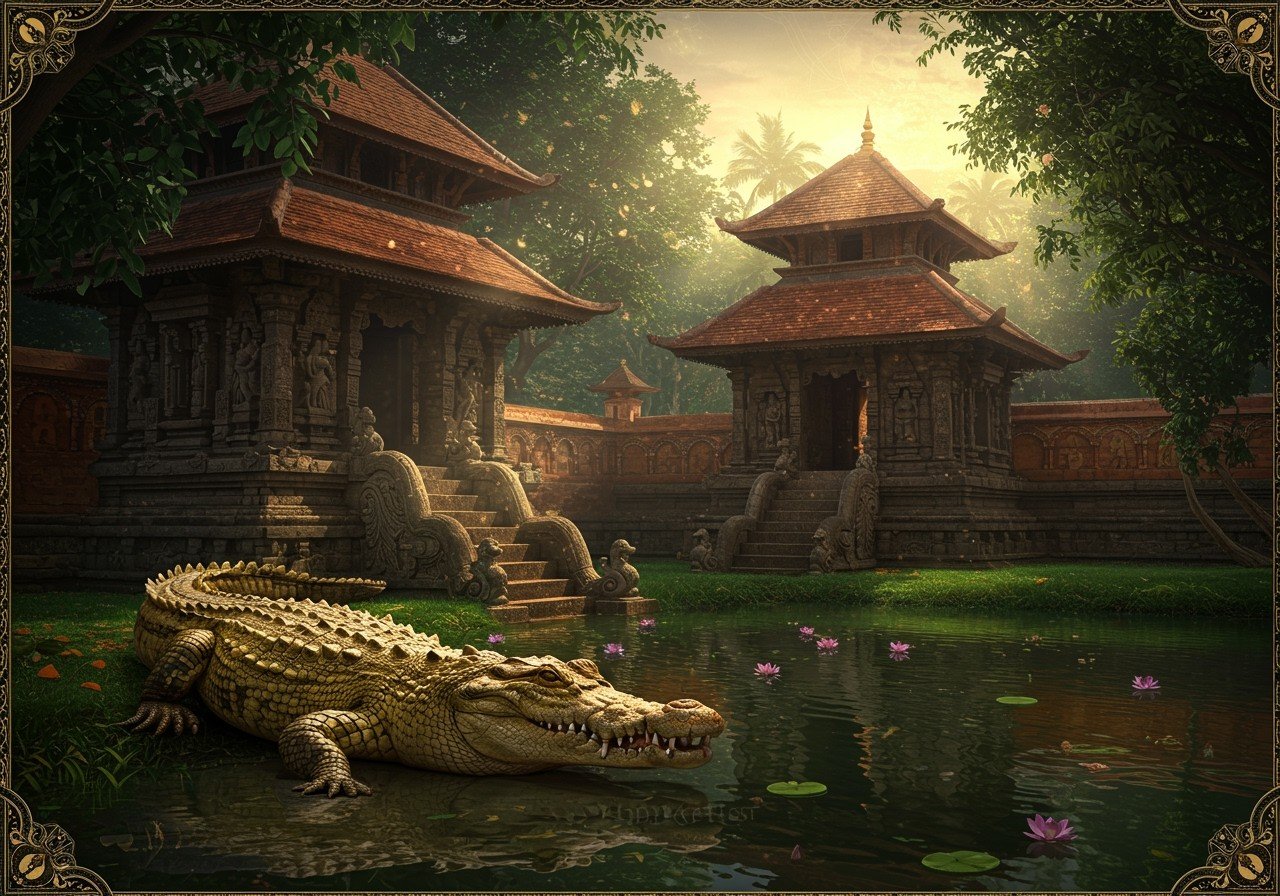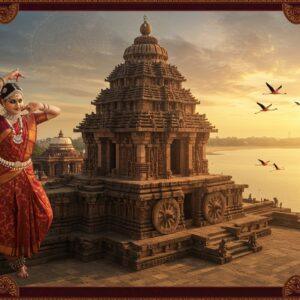
The Madhur Temple, nestled in Kerala’s Kasaragod district, is a place of deep-rooted tradition and captivating myths. Renowned for its magnificent architecture, this temple, dedicated to Lord Shiva, serves as a vibrant center for cultural and religious practices. The intriguing legend of a sacred crocodile associated with the temple adds to its mystique, drawing devotees and curious travelers alike. Let’s delve into the temple’s history and the enchanting tale of its legendary guardian, while acknowledging the similar, yet distinct, legend of Babiya at Ananthapura Lake Temple.
A Glimpse into Madhur Temple’s History
The Madhur Temple’s roots can be traced back to the Mayura Varma dynasty. This revered site, dedicated to Lord Shiva, showcases a unique blend of Kerala and Dravidian architectural styles. Situated along the tranquil banks of the Madhuvahini River, the temple exudes a serene spiritual atmosphere. Over the centuries, it has served as a central hub for various cultural and religious events. Historical happenings, including numerous renovations and restorations, have shaped the temple’s present form, keeping its rich heritage vibrantly alive. You might also be interested in reading about the significance of Lord Varahaswamy and the Sri Vedadri Lakshmi Narasimha Swamy Temple.
Unraveling the Legend of the Crocodile
Madhur Temple, shrouded in an aura of mystique, holds a special place in the hearts of the people in Kasaragod, Kerala. Dedicated to Lord Shiva, this temple is also intertwined with captivating folklore. One such tale revolves around a legendary crocodile, believed to be a divine protector of the sacred grounds. This narrative differs from the tale of Babiya at Ananthapura Lake Temple, where the crocodile is believed to be vegetarian and connected to a cave where Lord Krishna disappeared.
The Sacred Crocodile: A Symbol of Protection
Local lore portrays the crocodile as a guardian, vigilantly watching over the temple and its devotees. This differs from the Ananthapura Lake Temple legend, where Babiya is considered a messenger of the deity and is said to have a vegetarian diet. Here, the crocodile embodies a spiritual aura of protection, ensuring the sanctity of the temple. It is not linked to any specific deity’s disappearance, as is the case with Babiya at Ananthapura Lake Temple. It is revered as a protector of the sacred space, ensuring peace and divine energy within the temple’s boundaries.
A Cherished Tale in the Local Community
The community surrounding Madhur Temple deeply cherishes this myth, viewing it as an integral part of their cultural heritage. For some, the crocodile symbolizes strength and resilience, embodying the power to overcome obstacles. Others view it as a divine messenger, connecting the earthly realm with the spiritual. Devotees often recount stories of the crocodile’s presence during important rituals and ceremonies, further solidifying its significance in their faith. They speak of witnessing the crocodile basking in the sun near the temple pond or even appearing during special pujas, adding a mystical element to their spiritual experiences.
Rituals and Ceremonies Honoring the Guardian
Annual rituals are performed to honor the crocodile’s role as the temple’s spiritual guardian. These ceremonies, including heartfelt prayers and symbolic offerings, seek blessings for prosperity and protection. They are a testament to the deep cultural bond between the temple and its legendary protector. Devotees gather to offer special prasad and perform aarti, seeking the crocodile’s continued protection and blessings for the community.
The Crocodile’s Symbolism in Hindu Mythology
Crocodiles hold profound symbolic meaning within Hindu mythology. Often depicted as protectors, they embody qualities of vigilance, strength, and unwavering power. At Madhur Temple, this symbolism amplifies the spiritual atmosphere, drawing visitors from far and wide. It adds a layer of mystique to the temple, making it a place where devotees feel safe and connected to the divine.
A Magnet for Devotees and Tourists
The legend of the sacred crocodile adds a unique allure to Madhur Temple, attracting both devout pilgrims and inquisitive tourists. The myth offers a glimpse into the rich cultural tapestry of the region, blending spirituality and folklore. It invites visitors to explore its mysteries and connect with a tradition that has been passed down through generations. You can explore our collection of decorative items and holy books at poojn.in.
Preserving the Legend in Modern Times
Today, Madhur Temple continues to embrace and celebrate its crocodile legend. Local storytellers keep the myth alive, sharing its captivating details with visitors eager to experience the temple’s charm. Digital platforms have also played a crucial role in disseminating this enchanting tale beyond geographical boundaries, ensuring its preservation for generations to come. The temple authorities maintain a respectful approach towards the legend, acknowledging its cultural significance without promoting unfounded claims.
Poojn.in: Connecting You with Sacred Traditions
At Poojn.in, we understand the importance of connecting with sacred traditions. We offer a wide range of puja items to enhance your spiritual practices. Our Maa Manasa Murti, Laddu Gopal Murti, and Durga Puja Dashakarma Kit are crafted with utmost care and reverence.
- Pure copper water vessels: Ideal for sacred water offerings, these vessels are crafted with high-quality copper known for its purity and spiritual significance. They add a touch of tradition to your puja rituals.
- Traditional brass deepams: Our brass deepams illuminate your aarti ceremonies with a warm, inviting glow. Crafted with intricate details, they enhance the spiritual ambiance of your home.
- Natural cotton wicks for ritual lamps: Made from pure cotton, our wicks ensure a clean and steady flame for your oil lamps, creating a serene atmosphere for your prayers.
- Pure ghee for sacred offerings: We offer pure ghee, considered sacred in Hindu rituals. It is ideal for offering to deities and adds a traditional touch to your ceremonies.
- Authentic kumkum and chandan for tilak: Our kumkum and chandan are sourced from reliable suppliers and are perfect for applying tilak during pujas and ceremonies.
To order these and other puja essentials:
- Visit www.poojn.in
- Call us at 03369029784
- WhatsApp us at 9476142738
We offer secure pan-India delivery to ensure your items arrive safely and maintain their sanctity. Each product comes with clear usage instructions in multiple languages. Poojn.in makes it easy for you to access genuine puja items without leaving your home, allowing you to focus on your spiritual practices with convenience and authenticity. Our collection includes items for different occasions including flammables, holy clothing, and handcraft wooden masks . Consider buying Falcon brand items for guaranteed quality.
Embracing the Timeless Charm of Madhur Temple
The Madhur Temple crocodile legend continues to fascinate, weaving a vibrant tapestry of history, spirituality, and community. This sacred narrative not only enriches the temple’s legacy but also strengthens the cultural fabric of Kasaragod. As devotees and visitors gather to pay homage to the legendary guardian, they participate in a tradition that has stood the test of time. By cherishing and sharing this captivating tale, we ensure the mystique of Madhur Temple lives on, inviting all to embrace its timeless charm.
Common Questions about the Madhur Temple and Its Crocodile Legend
What is the legend about? The legend tells of a mystical crocodile, believed to be a divine guardian, protecting the temple’s sacred pond. Locals revere this crocodile, viewing it as a protector of the temple and its devotees. The tale differs from that of Babiya at the Ananthapura Lake Temple, which emphasizes the crocodile’s vegetarian diet and connection to Lord Krishna’s disappearance.
Where is the temple located? Madhur Temple is situated in Kerala, India, a region known for its rich cultural heritage and serene landscapes. This location adds to the temple’s spiritual significance, attracting pilgrims and tourists alike.
What’s the historical significance of the temple? Madhur Temple is celebrated for its ancient architecture, intricate carvings, and historical importance. Having served as a place of worship for centuries, it stands as a testament to the region’s rich religious traditions.
Which river flows near the temple? The Madhuvahini River flows near Madhur Temple, enhancing its scenic beauty and spiritual ambiance. The river’s presence adds to the temple’s tranquil atmosphere, providing a serene backdrop for prayer and reflection.
Why is the crocodile considered mysterious? The crocodile’s unexpected appearance in the temple’s pond and its revered status as a divine guardian add to its mystique. Unlike ordinary crocodiles, this one is believed to possess a spiritual connection to the temple.
How does the temple’s story connect with the crocodile? Local folklore intertwines the Madhur Temple story with the crocodile, emphasizing its role in protecting the temple and its devotees from harm. The crocodile is seen as an integral part of the temple’s narrative.
Are there any annual events related to the legend? Yes, Madhur Temple hosts annual festivals that celebrate the crocodile legend, attracting visitors and devotees from all corners of the world. These festivals offer a unique opportunity to experience the temple’s rich cultural traditions.
What makes this temple a popular pilgrimage site? Madhur Temple draws pilgrims and tourists due to its historical significance, stunning architecture, and the intriguing crocodile legend. The combination of history, spirituality, and mystique makes it a compelling destination.


